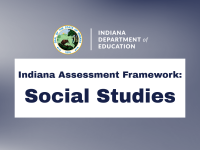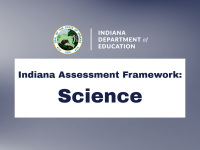Resources FILTERED
SOR Experts Explain Series: An Evidence-Aligned Framework for Reading Assessment
Is your reading assessment system aligned to what you’re learning about the science of reading? Do you ever feel that you have too many tests to...
Online Learner Support Systems: The ACE Framework
What supports systems assist online learners? Who provides support and what kind of support is most beneficial? Join Dr. Jered Borup, researcher and...
Framework for Connecting the Student and Teaching Practices
This free resource from Solution Tree Press provides educators with a framework for integrating the Mathematical Process Standards (called Standards...
Indiana Assessment Framework: Social Studies
The Indiana Assessment Frameworks provide a cohesive place for all instructional resources related to assessments, including Test Blueprints, Item...
Indiana Assessment Framework: Science
The Indiana Assessment Frameworks provide a cohesive place for all instructional resources related to assessments, including Test Blueprints, Item...
Indiana Assessment Framework: ELA
The Indiana Assessment Frameworks provide a cohesive place for all instructional resources related to assessments, including Test Blueprints, Item...
Indiana Assessment Framework: Mathematics
The Indiana Assessment Frameworks provide a cohesive place for all instructional resources related to assessments, including Test Blueprints, Item...
Improving Virtual Instruction Using the 4E Framework
Are you looking to level-up virtual instruction in your classroom? Join Dr. Jered Borup, researcher and professor at George Mason University, as he...
Educator Series: 2022 Grade 3 Science Standards and Framework
Join members of the Indiana Department of Education (IDOE) STEM Team to learn more about the 2022 Grade 3 Science Standards and Frameworks.Workshop...
The Hidden Potential of the Science of Reading: Screening and Instructing Language in Early Childhood
Think the Science of Reading begins with formal reading instruction? Think again! Join speech-language pathologist and literacy leader, Dr. Nell...
Science of Reading: Intermediate & Secondary Classrooms
Collection: #INLovesReadingJoin us for a discussion of the implementation of research-based strategies and interventions that can be used to support...
What's a CS Core Practice Anyway?
The Indiana Academic Computer Science Standards include both core concepts and core practices. The seven core practices of computer science (similar...
Knowledge Acquisition and Transformation
This workshop features Dr. Kay Wijekumar from Literacy.IO. A large population of students have not mastered reading comprehension....
From Objectives to Assessment: Crafting Cohesive Units with Backward Design with Dr. Catlin Tucker
This session will present a clear path for designing units that align the learning objectives and desired results with an assessment strategy that...
Civics Standards and Resources
This workshop focuses on middle school civics standards and resources. Participants will review the new 6th-grade Civics standards, resource guides,...
















 Login with Google
Login with Google
 Login with IDOE | Identity
Login with IDOE | Identity